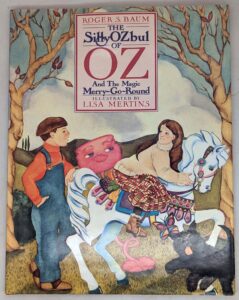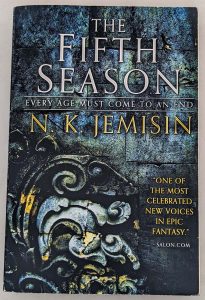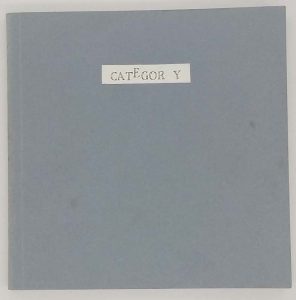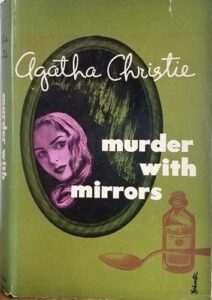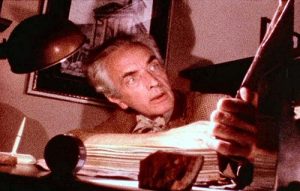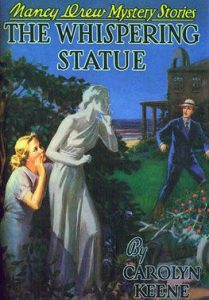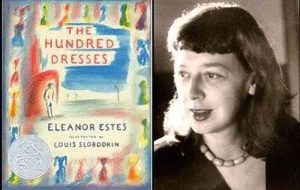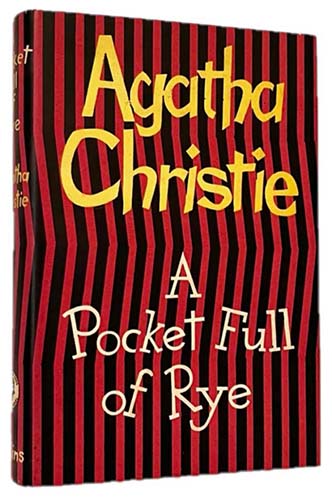
A Pocket Full of Rye is a work of detective fiction by Agatha Christie and first published in the UK by the Collins Crime Club on 9 November 1953, and in the US by Dodd, Mead & Co. the following year. The UK edition retailed at ten shillings and sixpence (10/6) and the US edition at $2.75. The book features her detective Miss Marple.
Like several of Christie’s novels (e.g., Hickory Dickory Dock and One, Two, Buckle My Shoe) the title and substantial parts of the plot reference a nursery rhyme, in this case “Sing a Song of Sixpence”. Miss Marple travels to the Fortescue home to offer information on the maid, Gladys Martin. She works with Inspector Neele until the mysteries are revealed.
Plot Summary
[SPOILER ALERT]
When London businessman Rex Fortescue dies after drinking his morning tea, Scotland Yard Detective Inspector Neele spearheads the investigation. An autopsy reveals the cause of death was poisoning by taxine, a toxic alkaloid obtained from the yew tree, and that Fortescue ingested it with his breakfast, while a search of his clothing reveals a quantity of rye in his jacket pocket.
Rex’s wife Adele is the main suspect in the murder. Son Lancelot and his wife Pat are travelling from Kenya to London, at the invitation of his father, according to Lance; at Paris, he wires that he will be home next day, and police meet him at the airport. The day Lance arrives at Yewtree Lodge, leaving his wife in London, Adele dies of cyanide in her tea, and a few hours later the maid Gladys Martin is found strangled in the yard, with a clothes peg put on her nose.
Inspector Neele is working full-time with the aid of Sergeant Hay on these murders, interviewing all at the office and in the home. The older son, Percival, tells the Inspector that his father was erratic and ruining the business. After the story of the three murders is in the newspapers, Miss Marple arrives at Yewtree Lodge to shed light on Gladys Martin, who learned serving and cleaning at Miss Marple’s home. Miss Ramsbottom, Rex’s sister-in-law, invites her to stay. Inspector Neele agrees to work with Miss Marple, seeing what she can add. Neele learns that the taxine was ingested in marmalade, with a new jar put out at breakfast used by Rex alone; that jar had been tossed in the yard and found by police. When Miss Marple and Inspector Neele discuss the case, she asks him if he has asked about blackbirds, having seen the pattern of the old children’s rhyme “Sing a Song of Sixpence.” When he does ask, he learns of dead blackbirds on Rex’s desk at home, a pie whose contents were removed and replaced with dead blackbirds, and from Lance, of the Blackbird Mine in east Africa.
The Blackbird Mine was found by a Mr MacKenzie and suspected of containing gold. Rex Fortescue investigated the land after investing capital in it, then left MacKenzie there to die, returning alone and owning the land that he felt was of no value. Mrs MacKenzie had subsequently blamed Rex for her husband’s death, promising to teach her children to avenge their father. Both the Inspector and Miss Marple suspect that the daughter is in the household under another name, as the son died in the war. The Inspector suspects Mary Dove, the housekeeper, and tells her so; later, Jennifer Fortescue, wife of Percy, tells Miss Marple that she was the MacKenzies’ daughter, and the Inspector confirms it. Jennifer put out the dead blackbirds near Rex to remind him of his past offence; Miss Marple realizes this gave the theme to the murderer. Dove immediately blackmails Jennifer; Inspector Neele says if Dove pays the money back, he will not charge her.
Miss Marple explains to Inspector Neele who killed Rex Fortescue: Gladys, who put the poison in the marmalade believing it was a truth drug, and the rye in his pocket, at the direction of her boyfriend, Albert Evans. The unattractive Gladys was very easy to persuade to assist him, never questioning his motives and flattered by his attentions. Miss Marple explains that Albert Evans is really Lance Fortescue, who wants the deed to the Blackbird Mine, as uranium has been found there. He arranged the murder of his father to stop the loss of cash and to deal only with his brother. He murdered his stepmother because she would inherit a large amount of money, but only if she lived thirty days after her husband, and he killed Gladys so she would not talk, leaving the clothes pin to match the line in the rhyme.
When Miss Marple returns home, a letter from Gladys waylaid in the post awaits her. She explains all she did and begs Miss Marple’s help, as she does not know what to do, and encloses a photo of her and her Albert – clearly Lance Fortescue. Inspector Neele’s case will be very strong.
Publication history
- 1953, Collins Crime Club (London), 9 November, hardcover, 192 pp.
- 1954, Dodd Mead and Company (New York), hardcover, 211 pp.
- 1955, Pocket Books (New York), paperback, 186 pp.
- 1958, Fontana Books (Imprint of HarperCollins), paperback, 191 pp.
The novel was first serialised, heavily abridged, in the UK in the Daily Express starting on Monday 28 September, running for fourteen instalments until Tuesday 13 October 1953.
The novel was first serialised in the US in the Chicago Tribune in forty-two parts from Monday, 11 January to Saturday, 27 February 1954.
A Pocket Full of Rye – First Edition Book Identification Guide
The books are listed in the order of publication. While the majority of Agatha Christie’s books were first published in the UK. There are many titles that were first published in the US. The title of the book may differs from the UK edition in some cases.
| Year | Title | Publisher | First edition/printing identification points |
|---|---|---|---|
| 1953 | A Pocket Full of Rye | William Collins & Sons, London, [1953] | First edition. "1954" on single line stated on the copyright page. No statement of later printings. Red cloth lettered in black. Price 10/6. |
| 1954 | A Pocket Full of Rye | Dodd, Mead & Co, NY, [1953] | First American edition. Copyright 1953 stated on the copyright page. No statement of later printings. Green boards lettered in red. Copyright date 1953, but published in 1954. Price $ 2.75. |
Note about Book Club Editions (BCE) and reprints:
UK: You can see statements of later reprint dates or of book club on the copyright page.
US: The US reprint publishers usually use the same sheets as the first edition and are harder to identify by looking at the title page or the copyright page. One may identify a BCE by looking at the DJ, which doesn’t have a price on top of the front flap and a “Book Club Edition” imprint at the bottom. If the dust jacked is clipped at both the top/bottom of the front flap. You can safely assume it’s a BCE . If the book is missing the dust jacket. Later BCE editions can be identified by its plain boards, while first printings are issued in quarter cloth.
Please refer to the gallery for detailed images of true first edition bindings and dust jackets.
A Pocket Full of Rye – First Edition Dust Jacket Identification Guide
First edition bindings and various dust jacket printings identification.

